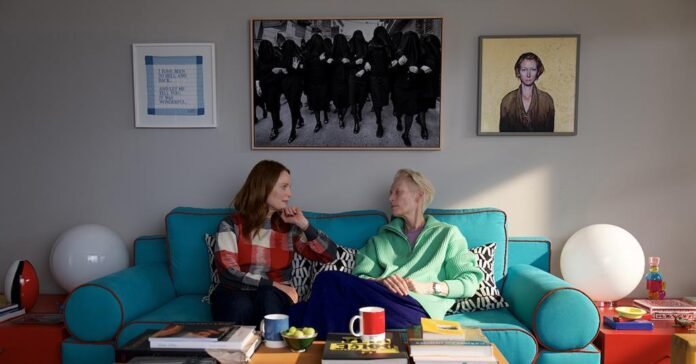Dir. Pedro Almodóvar. Spain 2024. 107mins
In the event you wished to present an instance of the auteur movie as Late Interval Contemplation, there could be few higher examples than Pedro Almodóvar’s Venice Competitors entry The Room Subsequent Door. The Man from La Mancha has, in current work, mused amply on mortality, reminiscence and remorse, notably in Julieta and Ache And Glory – and his new function has putting parallels with these, thematically and formally. However, for a narrative which ponders on late-life exhaustion and lack of curiosity and pleasure, The Room Subsequent Door strikes a defiant blow in opposition to ennui, staking out new territory for the director.
Almodovar has managed to depart his linguistic consolation zone whereas remaining fully, inimitably himself
After years of tantalising near-misses, the director’s first English-language function is each an enormous advance on his dud cod-Western brief Unusual Manner Of Life and a 100% Almodovarian movie, language however. A examine of friendship and complicity within the face of sickness, it contains a beautifully matched duo of Tilda Swinton and Julianne Moore, each on authoritative and transferring type, whereas the director’s formal and visible meticulousness is as finely honed as all the time – even when perilously verging on life-style stylish.
Solemnity of theme and execution, in addition to an erudite literary sensibility, will appeal to an older area of interest viewers, nevertheless it actually deserves consideration as one of many director’s extra looking ventures. Sony Photos Classics is planning an awards season run within the US from December 20, whereas Warner Bros will launch in Spain and key worldwide territories together with the UK.
Set within the US, and based mostly on a novel by American author Sigrid Nunez, it begins at a bookshop the place creator Ingrid (Moore) is signing copies of her new work, a cogitation on loss of life. Listening to that her previous pal, struggle reporter Martha (Swinton), is terminally sick, Ingrid visits her in hospital and the 2 ladies renew previous bonds. Martha tells Ingrid about her previous in a sequence of interpolated flashbacks, involving her teen years, her estranged daughter and a go to to Iraq – the latter awkwardly integrating with the remaining. It’s when Martha asks Ingrid to assist her face her impending loss of life that the that means of the title emerges: when Martha goes, she needs Ingrid to be there, actually and figuratively, within the room subsequent door.
The drama entails a specific problem for its leads: whereas Swinton’s character is the one which disaster impacts instantly, Moore’s position would look like one which entails complicity, a capability to hear quietly and to point out compassionate empathy. The 2 stars develop a ying-yang rapport – cool restraint, with flurries of frustration and anger in Swinton’s efficiency, and a young, philosophical heat from Moore. The 2 play off one another with a closeness that echoes (at some moments explicitly) the dynamics of Ingmar Bergman’s feminine duos.
Alessandro Nivola makes a short look as a cop with a extra judgmental tackle life than the opposite characters. And John Turturro, in an attractive position because the ex-lover of each ladies, communicates troubled stress as a person profoundly, even hopelessly anxious in regards to the state of the planet. His position, nonetheless, is among the movie’s much less convincing parts, a clumsy reminder of the brand new social accountability that has change into a part of Almodóvar’s late mode (as in Parallel Moms’ earnest deal with of the Spanish Civil Struggle).
Mortality has not often appeared so very elegant on display screen, and the stylistic polish right here might strike some as improper or diminishing of the movie’s theme. That may be a considerably puritanical view, though one would possibly baulk on the profligacy with which the director scatters literary, filmic and creative references all through – notably to The Lifeless (each James Joyce’s story and the John Huston display screen adaptation) and an outrageous, informal wink at Andrew Wyeth’s portray ‘Christina’s World’. However, on condition that this can be a story about the best way that, in late life, folks might lose their appetites for artwork, pleasure and the world, the density of allusiveness right here represents a boisterous resistance to the dying of the sunshine.
Discovering contemporary variants on a well-known Almodóvar home type, new manufacturing designer Inbal Weinberg channels, amongst different parts, the color palette of painter Edward Hopper. With Edu Grau’s camerawork highlighting a really manifest geometric precision (one leitmotif is a sure summary composition of shapes and hues in a doorway), this is among the director’s most eloquently meticulous works, the perfectionist artifice solely serving to amplify the movie’s emotional cost by framing it so rigorously. A gently austere rating by Almodóvar common Alberto Iglesias provides meditative echoes of Mahleresque or Strauss.
The place the movie will ultimately stand in Almodóvar’s canon stays to be seen, however it’s a substantial achievement from a director who has managed to depart his linguistic consolation zone whereas remaining fully, inimitably himself.
Manufacturing firm: El Deseo
Worldwide gross sales: El Deseo, eldeseo@eldeseo.es
Producers: Agustin Almodóvar, Esther Garcia
Screenplay: Pedro Almodóvar, based mostly on the novel What Are You Going By by Sigrid Nunez
Cinematography: Eduard Grau
Manufacturing design: Inbal Weinberg
Editor: Teresa Font
Music: Alberto Iglesias
Principal solid: Tilda Swinton, Julianne Moore, John Turturro, Alessandro Nivola
